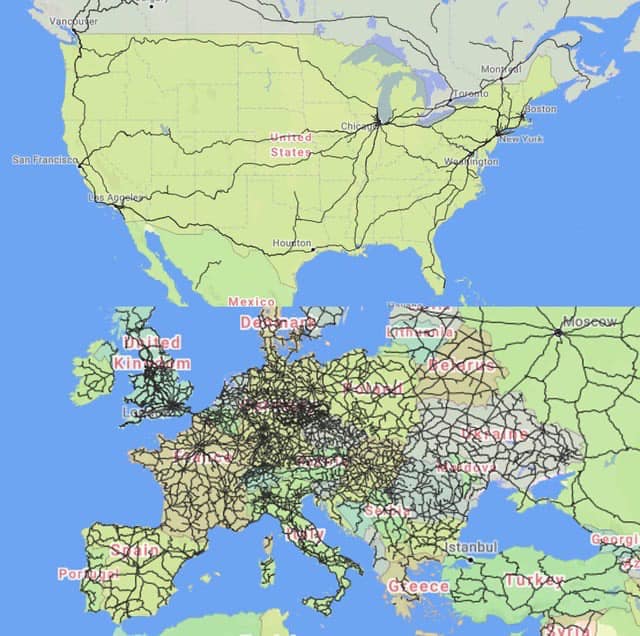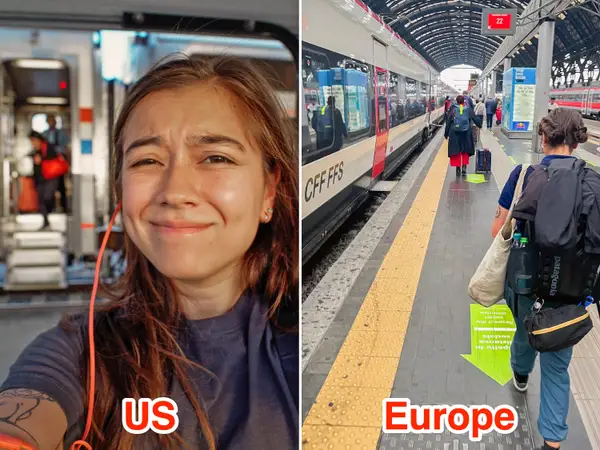Passenger train systems play a crucial role in shaping a region’s transportation infrastructure, economic development, and environmental sustainability. When comparing the passenger train networks of the United States and Europe, the contrast is stark. From infrastructure and technology to accessibility and cultural attitudes, the differences highlight varying priorities and approaches to public transit.

Historical Development: Diverging Paths
Europe’s Rail-Centric Growth
Europe’s passenger rail system has its roots in the Industrial Revolution and has continually evolved to remain a central mode of transportation. Governments across Europe invested heavily in rail infrastructure post-World War II, prioritizing public transit for urban and intercity travel. Rail travel became synonymous with speed, efficiency, and accessibility, supported by policies aimed at reducing car dependency.
America’s Automotive Focus
In the United States, the trajectory was vastly different. While railroads were instrumental in the 19th century, the mid-20th century saw a cultural and policy shift toward automobiles and airplanes. Suburban expansion, coupled with extensive investments in highways and airports, relegated passenger trains to the periphery of transportation priorities. The result was a fragmented and underfunded rail network that struggles to compete with other modes of travel.

Infrastructure and Network Density
Europe: Dense and Integrated
Europe boasts one of the most extensive and integrated rail networks in the world. Countries like Germany, France, and Italy have high-speed rail systems that connect major cities, while regional and commuter trains ensure coverage in smaller towns. Stations are often centrally located, making trains an accessible option for nearly everyone.
United States: Sparse and Limited
In contrast, passenger rail in the U.S. is sparse and often limited to specific regions. Amtrak, the national passenger rail service, operates on shared tracks with freight trains, leading to frequent delays and slower speeds. Most routes serve the densely populated Northeast Corridor, leaving much of the country with limited or no passenger rail options. Large swaths of rural America lack convenient train access, and even urban centers often lack well-integrated systems.
Speed and Technology
Europe: High-Speed Pioneers
Europe is home to some of the fastest trains in the world, including France’s TGV, Spain’s AVE, and Germany’s ICE. These trains operate at speeds exceeding 300 km/h (186 mph) on dedicated tracks, providing a viable alternative to air travel for distances under 1,000 kilometers (620 miles). Electrification is widespread, making European railways more sustainable and environmentally friendly.
United States: Playing Catch-Up
In the U.S., high-speed rail remains largely aspirational. The Acela Express, Amtrak’s fastest service, operates in the Northeast Corridor at speeds up to 150 mph but averages much lower due to track limitations. Projects like California’s high-speed rail are in development, but progress has been slow due to funding challenges, political opposition, and regulatory hurdles.
Affordability and Accessibility
Europe: Affordable and Universal
European countries prioritize affordability and accessibility in rail travel. Subsidies often keep ticket prices reasonable, and passengers benefit from frequent service, extensive coverage, and user-friendly ticketing systems. Rail passes like the Eurail enable travelers to explore multiple countries economically.
United States: Expensive and Infrequent
Passenger rail in the U.S. is generally more expensive and less frequent. Long-distance routes are often priced comparably to flights, and schedules can be inconvenient, with limited departures. For commuters, regional rail services in cities like New York and Chicago offer practical options, but coverage is inconsistent nationwide.
Environmental and Cultural Impacts
Europe: Sustainability Focus
European countries emphasize rail travel as part of their environmental goals. Electrified trains produce fewer emissions than cars or planes, aligning with climate policies aimed at reducing carbon footprints. Rail travel is also culturally ingrained, seen as a normal and practical choice for both short and long distances.
United States: Car-Centric Culture
In the U.S., the dominance of car culture and the convenience of domestic air travel overshadow passenger rail. Public transit, including trains, often faces stigma as a less desirable option compared to personal vehicles. Efforts to shift cultural attitudes are emerging but face significant resistance.
The Future of Passenger Trains
Europe: Advancing the Rail Revolution
Europe continues to innovate, with plans to expand high-speed networks, introduce hydrogen-powered trains, and integrate rail travel seamlessly with other modes of transportation. Initiatives like the European Green Deal underscore the importance of rail as a sustainable solution for future mobility.
United States: Slowly Building Momentum
The U.S. is making incremental progress. Federal funding for rail projects has increased, and states like California, Texas, and Florida are pursuing high-speed rail initiatives. However, challenges such as fragmented governance, regulatory complexities, and entrenched car and airline dominance must be addressed to see significant advancements.
Conclusion
The contrast between passenger trains in the United States and Europe reflects broader differences in priorities, policies, and cultural attitudes. While Europe’s rail systems exemplify efficiency, accessibility, and sustainability, the U.S. lags behind due to decades of underinvestment and competing transportation models. As the world moves toward more sustainable practices, the United States has an opportunity to reimagine its approach to passenger rail, drawing inspiration from Europe’s success while adapting solutions to its unique context.